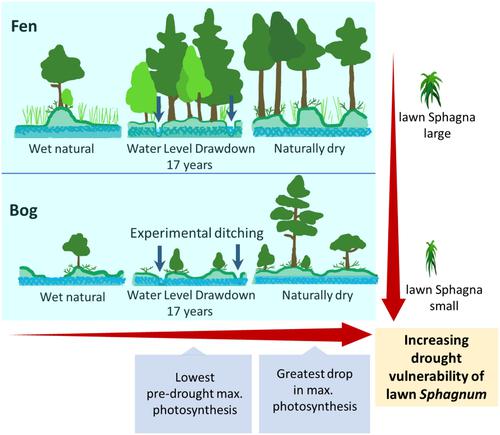Our official English website, www.x-mol.net, welcomes your feedback! (Note: you will need to create a separate account there.)
A deepened water table increases the vulnerability of peat mosses to periodic drought
Journal of Ecology ( IF 5.5 ) Pub Date : 2024-04-02 , DOI: 10.1111/1365-2745.14305 Nicola Kokkonen 1 , Anna M. Laine 1, 2 , Aino Korrensalo 1, 3 , Jelmer Nijp 4 , Juul Limpens 5 , Lauri Mehtätalo 3 , Elisa Männistö 1 , Eeva‐Stiina Tuittila 1
Here we address the combined impact of multiple stressors that are becoming more common with climate change. To study the combined effects of a lower water table (WT) and increased frequency of drought periods on the resistance and resilience of peatlands, we conducted a mesocosm experiment. This study evaluated how the photosynthesis of lawn Sphagnum mosses responds to and recovers from an experimental periodic drought after exposure to the stresses of a deep or deepened WT (naturally dry and 17‐year‐long water level drawdown [WLD] in fen and bog environments). We aimed to quantify if deep WTs (1) support acclimation to drought, or (2) increase the base‐level physiological stress of mosses or (3) exacerbate the impact of periodic drought. There was no evidence of acclimation in mosses from drier environments; periodic drought decreased the photosynthesis of all Sphagnum species studied. WLDdecreased the photosynthesis of bog‐originating mosses prior to periodic drought, indicating that these mosses were stressed by the hydrological change. Deep WTs exacerbated Sphagnum vulnerability to periodic drought, indicating that the combination of drying habitats and increasing frequency of periodic drought could lead to a rapid transition in lawn vegetation. Water‐retaining traits may increase Sphagnum resilience to periodic drought. Large capitula size was associated with a higher resistance; the bog originating species studied here lacked large capitula or dense carpet structure and were more vulnerable to drought than the larger fen originating species. Consequently, lawns in bogs may become threatened. Recovery after rewetting was significant for all mosses, but none completely recovered within 3 weeks. The most drought‐resilient species had fen origin, indicating that fens are less likely to undergo a sudden transition due to periodic drought. Synthesis : Water level drawdown associated with climate change increases the sensitivity of Sphagnum mosses to periods of drought and moves them closer to their tipping point as species on the edge of their ecological envelope rapidly shut down photosynthesis and recover poorly.
中文翻译:

地下水位加深增加了泥炭藓对周期性干旱的脆弱性
在这里,我们讨论了随着气候变化而变得越来越普遍的多种压力因素的综合影响。为了研究较低的地下水位(WT)和干旱期频率增加对泥炭地抵抗力和恢复力的综合影响,我们进行了中生态实验。这项研究评估了草坪的光合作用如何泥炭藓属 在暴露于深层或加深的WT(沼泽和沼泽环境中自然干燥和长达17年的水位下降[WLD])的压力后,苔藓对实验性周期性干旱做出反应并从中恢复。 我们的目的是量化深层WT是否(1)支持干旱适应,或(2)增加苔藓的基础水平生理应激或(3)加剧周期性干旱的影响。 没有证据表明苔藓会适应干燥环境;周期性干旱降低了所有植物的光合作用泥炭藓属 研究的物种。在周期性干旱之前,WLD 降低了源自沼泽的苔藓的光合作用,表明这些苔藓受到水文变化的胁迫。深部WT加剧泥炭藓属 易受周期性干旱的影响,表明干燥的栖息地和周期性干旱频率的增加可能导致草坪植被的快速转变。保水性状可能会增加泥炭藓属 抵御周期性干旱的能力。头状花序越大,抵抗力越高。这里研究的沼泽起源物种缺乏大的头状花序或致密的地毯结构,并且比较大的沼泽起源物种更容易受到干旱的影响。因此,沼泽中的草坪可能会受到威胁。 所有苔藓在重新润湿后都有显着的恢复,但没有一个在三周内完全恢复。最耐旱的物种起源于沼泽,这表明沼泽不太可能因周期性干旱而发生突然转变。 S综合 :与气候变化相关的水位下降增加了敏感性泥炭藓属 苔藓进入干旱期,并使它们更接近临界点,因为处于生态包络边缘的物种迅速关闭光合作用并恢复不良。
更新日期:2024-04-02
Journal of Ecology ( IF 5.5 ) Pub Date : 2024-04-02 , DOI: 10.1111/1365-2745.14305 Nicola Kokkonen 1 , Anna M. Laine 1, 2 , Aino Korrensalo 1, 3 , Jelmer Nijp 4 , Juul Limpens 5 , Lauri Mehtätalo 3 , Elisa Männistö 1 , Eeva‐Stiina Tuittila 1
Affiliation

|
中文翻译:

地下水位加深增加了泥炭藓对周期性干旱的脆弱性



























 京公网安备 11010802027423号
京公网安备 11010802027423号